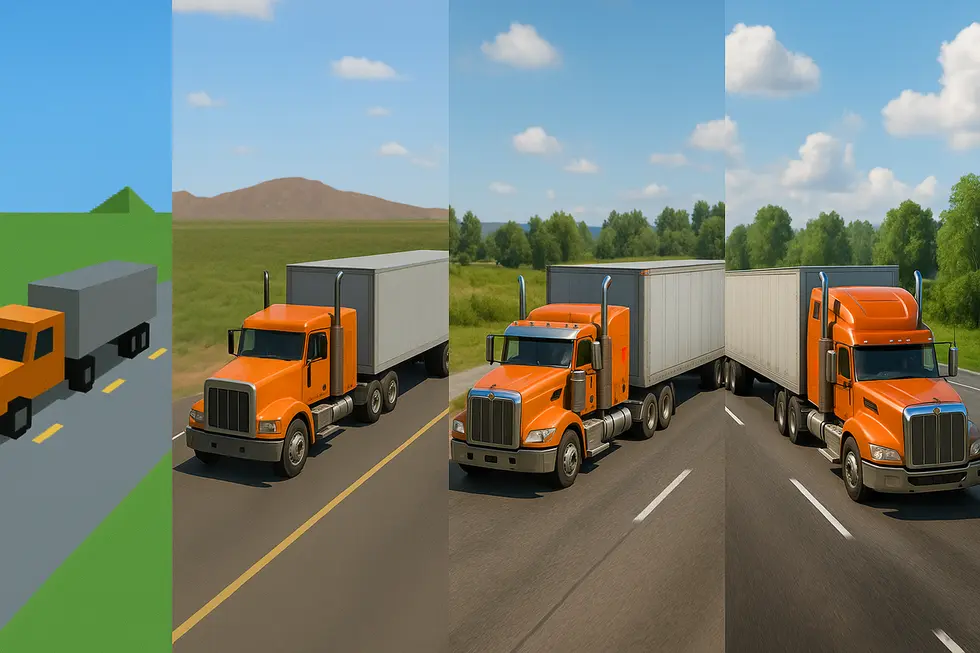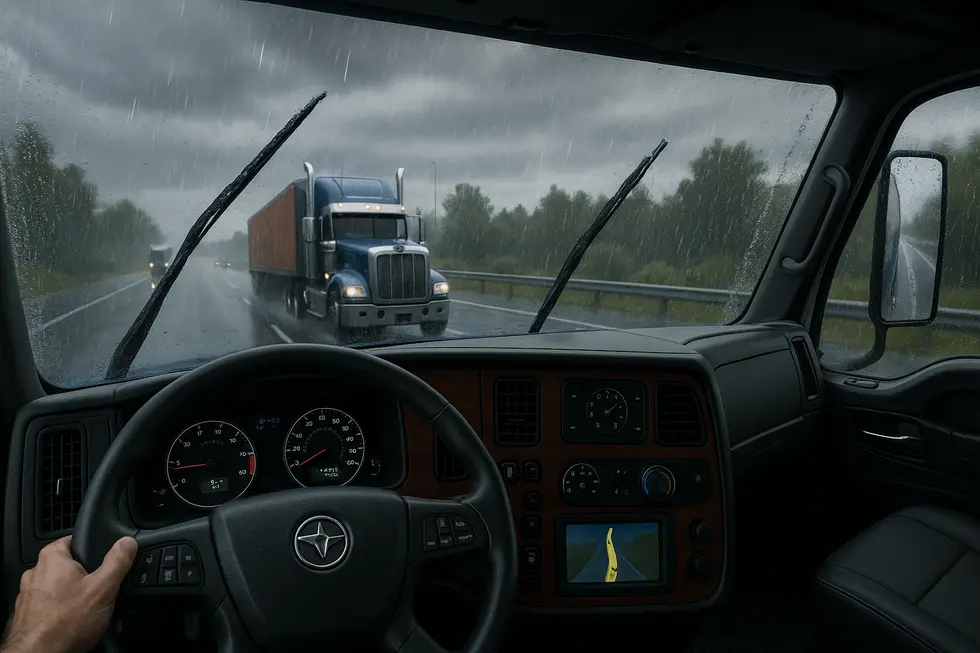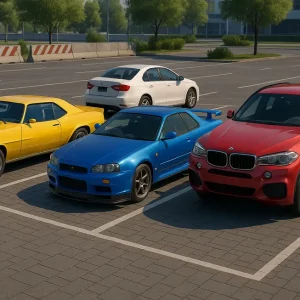Truck simulator games have captured the imaginations of mobile gamers worldwide, offering an exhilarating experience of driving big rigs right from your Android device. These games are not just about driving; they provide seamless realism, immersive terrains, and tasks that mimic real-life trucking challenges. For gaming enthusiasts, the chance to navigate these virtual landscapes and complete engaging missions has made truck simulators an unmissable genre in mobile gaming.
The Evolution of Truck Simulator Games for Android

1. From Pixels to Perfection: Graphics and Gameplay in Android Truck Simulators
The evolution of graphics and gameplay in truck simulator games for Android mirrors the broader technological advances in gaming. This progression has transformed the way players experience virtual trucking, enhancing both visual appeal and gameplay depth—from crude pixel graphics to immersive 3D worlds, and from basic driving mechanics to intricate simulations.
Graphics Over Time:
In the early days of video games, visuals were simple and pixelated, largely constrained by the limited technology of the 1950s to the 1970s. Games like Pong and Tennis for Two with their basic lines and blocks set the stage for future evolution. The late 1970s ushered in RGB and vector graphics, which made it possible for games to include more colors and complex designs. Truck simulators benefitted greatly as these technologies gradually became accessible for mobile platforms, transitioning from pixel art to more detailed textures that mimic real-life truck details.
The real leap occurred in the mid-1990s with the introduction of 3D graphics. Hardware like the Voodoo Graphics card revolutionized visuals by supporting hardware-accelerated textures and dynamic lighting, crucial for creating the lush, detailed environments seen in modern truck simulators. For Android platforms, the optimization of these graphics allowed games to offer players picturesque sceneries and vehicles with unprecedented realism, akin to console and PC levels.
Today, advanced graphics techniques such as ray tracing are applied in Android games, providing stunningly lifelike simulations. Players can enjoy intricate details in their virtual trucks and the dynamic, changing landscapes they traverse, offering a truly immersive experience that parallels the photorealism of games found on more powerful platforms.
Gameplay Innovations:
Originally, gameplay was quite limited; early video games offered basic controls and minimal interactivity due to technological constraints. However, as tech capabilities expanded, so too did gameplay possibilities. Enhanced processing power and storage solutions have enabled the creation of expansive open-world environments for players to explore with their virtual big rigs.
The inclusion of online multiplayer modes has transformed truck simulators on Android into social experiences, allowing drivers to interact, compete, or cooperate in virtual trucking communities. Here, players can participate in real-time missions, haul cargo across diverse terrains, or simply enjoy a leisurely drive in a detailed world, adding layers of replayability and engagement.
Moreover, the advent of downloadable content (DLC) and in-app purchases offers players ways to customize their experiences further, ensuring that their simulated adventures remain fresh and personalized. This evolution not only provides players with more control over their gaming environment but also supports the growing trend of blending game narratives with complex AI, encouraging more meaningful player engagement and interaction.
In conclusion, the journey from simple 2D designs to sophisticated 3D landscapes in Android truck simulators highlights a broader trend in the gaming industry—a relentless pursuit of realism and engagement, facilitated by relentless technological innovations. As these games continue to evolve, they will likely narrow the gap between virtual simulations and the nuances of actual truck driving, making them an everlasting staple in the realm of mobile gaming.
2. Multiplayer Modes: Driving Together on the Digital Highway
Since their inception, truck simulator games have consistently pushed the envelope of what’s achievable in mobile gaming. As these games matured, their evolution wasn’t just limited to visuals and gameplay mechanics; a significant turning point came with the inclusion of multiplayer modes. This leap was supported by advances in both graphical technology and gameplay design, reshaping how players interacted with and experienced the virtual trucking world.
The transition from solitary play to communal experiences in truck simulators offers players a collaborative platform. Initially, truck simulator enthusiasts could only share their feats through screenshots and forum stories. The multiplayer revolution changed all that. Through seamless online connections, players are now able to convoy together, share tasks, and engage in real-time communication while navigating diverse landscapes. This cooperation introduces a new layer of strategic gameplay; teamwork is paramount, whether you’re planning the most efficient routes or aiding a fellow driver who’s found themselves in a jam.
Beyond camaraderie, multiplayer modes introduce competitive elements. Players can participate in timed events, leaderboard challenges, or cargo delivery races, all of which enhance the replayability factor. This shift from single-player to multiplayer didn’t happen overnight; it was made possible by the expansive evolution of gaming technology from early pixelated games to sophisticated, interconnected cyberspaces (source).
The essence of multiplayer trucking is heavily reliant on robust internet connectivity, which owes its development to wider advancements in digital platforms and cloud gaming infrastructure. This technology ensures that multiplayer modes are not just a series of linked players, but an interconnected world where players can stream their journeys worldwide or compete with each other irrespective of rigid hardware limitations. Explore more multiplayer game mechanics with Car Parking Multiplayer, showcasing real-time synchronization in gaming.
Ultimately, the rise of multiplayer modes has transformed truck simulator games into a communal affair. It accentuates the social dynamics in gameplay, allowing players to not only experience the lone journey of a truck driver but also the shared odyssey of a convoy, creating a richer, more vibrant gaming experience. As technology continues to evolve, it will be fascinating to see how multiplayer gaming grows, offering even more complex and immersive environments for truck simulation aficionados.
Realism and Immersion in Truck Simulator Games

1. Mastering the Dynamics: The Art of Realistic Driving Physics
In the world of truck simulator games, one of the most compelling elements that hooks players is the realistic driving physics. These sophisticated systems are the core of the immersive experience, forming the invisible yet palpable connection between the player and the virtual world. By simulating realistic vehicle behavior, players feel the true weight and grandeur of commandeering a massive truck, maneuvering through diverse landscapes—a testament to the power of intricate physics modeling.
The Underpinnings of Realistic Simulation
Realistic driving physics are not merely a collection of coded rules but a harmonious blend of complex algorithms representing the physical interactions of a vehicle’s components. Each element, from the tires gripping the road to the dynamic balance of the chassis, plays a crucial role in bringing authenticity to virtual truck driving.
Tire Behavior and Grip: The foundation of realistic driving lies in tire modeling, where slip angles, friction coefficients, and load-dependent grip variations are crucial for an authentic steer. This detailed approach to tire simulation helps in preventing unrealistically easy slides or drifts, making the driving experience closer to reality. Tires, after all, are the vehicle’s sole contact with the road, and accurate simulation here is indispensable.
Suspension and Chassis Dynamics: This aspect of physics handling involves meticulous modeling of each suspension component—springs, dampers, and connection joints—that ensures the vehicle responds naturally to every bump and curve of the road. The way the chassis flexes under stress, or how weight transfers as you turn or accelerate, crucially affects handling, giving life to the simulation by mimicking real-world vehicle dynamics. This modeling is critical in conveying the sensation of driving a lumbering giant like a big rig.
Engine and Power Transmission: Finally, an accurate simulation of engine torque, transmission mechanics, and power delivery forms the backbone of any realistic driving physics. Understanding the intricacies of how power is distributed to the wheels allows players to manage acceleration and braking with finesse, ensuring that throttle inputs translate to mindful, realistic movements.
Emblematic Exemplars of Realism
Historically, racing simulators like iRacing and BeamNG.drive have set the benchmark in this field by offering unprecedented realism. iRacing, famous for its laser-scanned circuits and precise vehicle replicas, has established a high bar for other simulators aiming for realism. Similarly, BeamNG.drive, with its soft-body physics, excels in showcasing how a vehicle’s components interact in real-time to produce organic deformation and movement.
Meanwhile, game engines like Unity and Godot have provided developers with specialized tools such as Vehicle Physics Pro and VitaVehicle, enabling them to craft staggeringly realistic experiences on mobile platforms and beyond. These tools facilitate customization while maintaining fidelity to the physics of real-world driving.
Balancing Realism and Accessibility
Developers face the challenge of balancing realism with performance and accessibility. On mobile devices, where Truck Simulator Big Rigs for Android typically operates, maintaining smooth performance without sacrificing authenticity is key. Solutions like Rigidbody engines in physics systems provide this balance, ensuring that the complex dynamics of truck driving are effectively translated onto a platform with more limited computational power.
Overall, the realistic driving physics in truck simulator games not only enhance immersion but also elevate the entire experience to something that is more than just a game. By faithfully replicating the intricate dance between mechanics and physics, these simulators empower players to live the life of a trucker on the move, capturing the essence of their virtual journeys with breathtaking accuracy.
2. Crafting Authentic Driving Worlds: The Virtual Realities of Big Rig Simulators
In the vibrant realm of truck simulator games on Android, nothing transports players into the driver’s seat quite like the artful creation of immersive virtual environments. Achieving unparalleled realism hinges on an intricate web of sophisticated technologies and methodologies, each contributing to a lifelike driving experience that tantalizes enthusiasts and novices alike.
At the heart of this realism is realistic driving physics, a cornerstone that defines the authenticity of simulation. Modern simulators strive to faithfully replicate real-world vehicular dynamics, capturing the nuances of how multiple forces interact with both vehicle and environment. This begins with meticulous vehicle dynamics modeling. It’s crucial to understand how forces such as traction, acceleration, braking, and weight transfer interplay with the vehicle’s suspension system. This careful orchestration ensures that players experience accurate handling characteristics, whether it’s the sudden understeer in a tight corner or the delicate balance required when navigating heavy cargo.
Tires represent the only contact points between a truck and the road, making tire behavior a pivotal aspect of realism. Advanced simulations depict the minor deformations and frictional nuances that dictate grip and slip. By accurately modeling these phenomena, simulators can convey the feel of a slick tarmac under rainy conditions or the unforgiving gravel of a rugged path, melding the thrill of unpredictability with the driver’s skill.
To complement these visual and mechanical dynamics, force feedback brings the virtual world to life through physical sensations, such as the subtle vibrations felt during tire traction loss or the rough textures of road surfaces. Such feedback systems enhance immersion, bridging the gap between screen and reality by echoing physical sensations known to seasoned drivers.
Simulations like BeamNG.drive further push the boundaries with soft-body and structural simulation. This approach models vehicles with nodes and beams, allowing for stunningly realistic deformation and crash physics. Players witness not just visual damage but also the consequent impact on a vehicle’s handling and performance, effectively turning each drive into a dynamic challenge where decisions have tangible consequences.
Equally important is the powertrain and transmission aspect, where engine and drivetrain dynamics are meticulously modeled. Through precisely calculated torque curves and gear ratios, simulators ensure that every shift, acceleration, and deceleration feels genuine. The enthralling tug of engine forces and the precision of wheel spin echo the struggles of real-world trucking, offering players a slice of authentic professional driving.
For developers, middleware tools such as Vehicle Physics Pro provide a robust platform, allowing for detailed customization of physics models, which can cater to the broad spectrum of vehicle types seen in simulators. These tools are vital in overcoming the trade-offs between realism and accessibility. While highly realistic simulations may introduce steep learning curves, careful design and certain limitations help maintain competition fairness and player engagement without sacrificing depth.
By weaving together intricate physics simulations with immersive sensory feedback, truck simulator games offer an unparalleled window into the world of big rigs. This dedication to realism and immersion transforms each virtual journey into an engaging narrative, echoing the trials and triumphs of real-world trucking adventures.
For more insights into engaging driving experiences on Android, explore the multifaceted world of car parking simulations.
Popular Truck Simulator Games for Android

1. Exploring the Pinnacle of Mobile Truck Simulators
Truck simulator games have carved a niche in the mobile gaming domain, offering players a diverse range of experiences that simulate the life of a truck driver. As the demand for quality simulation games continues to rise, truck simulator titles have emerged as a point of fascination for many Android users. Among these, some games have not only resonated with the masses but have stood out for their innovation and deep gameplay.
Delving into the heart of these games reveals why they are celebrated. Truck Simulator: Ultimate encapsulates a perfect blend of simulation and management, providing a holistic truck driving experience. The game doesn’t just stop at driving but extends into managerial responsibilities, urging players to build and expand their trucking fleets, much like a mini-enterprise on their phones. This continuous evolution and content updates have kept the game fresh and highly engaging.
Another noteworthy mention is Truck Simulator Big Rigs, which has earned praise for its expansive open-world settings. These settings are intricately crafted, echoing familiar American landscapes, and infused with realistic driving mechanics. Players appreciate the degree of control and tailoring offered as they customize their trucks and manage logistics. This game stands as a testament to how mobile platforms are narrowing the gap with console counterparts in terms of sophistication and depth.
These games not only entertain but educate by providing a platform to understand logistical management and strategic planning, all in the guise of entertainment. They are frequently updated to include new models and missions, reflecting real-world trucking scenarios such as changes in routes and cargo types. This adds a layer of realism that draws players back time and again.
However, the market is not without its challenges. While the initial downloads for these games are usually free, many offer in-app purchases that enhance the gameplay. Whether it’s acquiring new trucks or unlocking special missions, these purchases support developers but also introduce a business model that can impact accessibility. Despite this, the sheer volume and variety of truck simulators available ensure that every player can find a game that fits their preference without breaking the bank.
For those who prefer easy access and the freedom to explore or compete at their own pace, mobile truck simulators on Android offer something uniquely satisfying. Their ability to simulate a hands-on truck driving experience, combined with strategic elements, makes them a compelling choice for both casual gamers and trucking enthusiasts alike.
As technology advances, the line between mobile capabilities and traditional gaming platforms continues to blur, which promises an exciting future for truck simulator games on Android. From intricate graphics to enhanced AI-driven challenges, the evolution of these games is something players eagerly anticipate. Hence, it’s not just about driving anymore; it’s about living the life of a trucker in a world of endless opportunities.
2. Exploring Gameplay Features and Player Feedback
In the vibrant world of truck simulator games for Android, exploring gameplay features and the assorted player reviews offers insights into what makes these games truly captivating. These mobile experiences are defined by a commitment to realism, from intricately detailed environments to authentic truck mechanics, and even the quintessential challenges of long-haul journeys.
Immersive Gameplay Mechanics
The heart of any successful truck simulator is its ability to replicate the nuances of real-world trucking. Many top-rated games like Truck Simulator: Ultimate and Truck Simulator Big Rigs offer not just standard driving mechanics but also advanced features like manual gear shifting, customizable trucks, and realistic physics that simulate the weight and movement of these massive vehicles carrying various types of cargo. These elements lend a layer of depth that appeals to veteran players seeking a lifelike experience.
The games also introduce management elements, allowing players to build and grow their own trucking companies. This tycoon aspect adds a strategic layer, where players must balance logistics, upkeep, and expansion efforts, making gameplay more varied and engaging. Titles often include day-night cycles and dynamic weather systems, further enhancing the realism by requiring players to adapt their strategies to different driving conditions.
Diverse Environments and Missions
A significant draw of these simulators is the sprawling landscapes they offer. For a mobile game to stand out, it must present players with a veritable world that feels lived-in and expansive. From urban sprawls threaded with traffic and narrow streets to the sun-drenched highways of the American Southwest, as vividly realized in Truck Simulator Big Rigs, the diversity of settings invites exploration. The graphics and attention to detail ensure that every drive feels unique.
Missions in these games range from routine cargo deliveries to more challenging expeditions requiring strategic navigation through complex terrains. Player engagement increases as they earn rewards, customize their rigs, and unlock new routes. This progression sustains interest over longer periods, allowing players to invest more deeply in their virtual career.
Player Reviews and Community Insights
Feedback from the gaming community often underscores the quality and potential enhancements of these simulators. Most reviews applaud the attention given to satisfying aesthetics and realistic gameplay. Titles like Truck Simulator: Ultimate are frequently praised for their graphic fidelity and the sheer scope of their maps, allowing players to drive for hours without encountering repetition.
However, like many freemium games, these simulators sometimes draw criticism for in-app purchases and ads, which can disrupt the immersive experience they strive to create. Developers often address these concerns by offering a balanced approach, with optional premium features that do not gate critical gameplay components.
Final Observations
The landscape of truck simulators on Android is rich and varied, offering games that cater to different tastes, whether players seek hardcore realism or a more laid-back, arcade-style trucking adventure. As technology continues to evolve, these games will likely grow even more sophisticated, offering deeper immersion and even more expansive virtual landscapes for players to explore. For those looking to download these experiences, exploring trusted game app sources can provide safe and easy access to top-rated simulators that promise endless adventures on the open road.
The world of truck simulator games for Android opens up vast horizons for gamers, blending excitement with a taste of the trucking life. These games have captivated audiences with their realism and expansive gameplay, making them a staple for mobile gaming enthusiasts. As technology progresses, we can anticipate even more sophisticated trucking simulations, offering endless adventures on digital roads.


 Table Contents
Table Contents 


